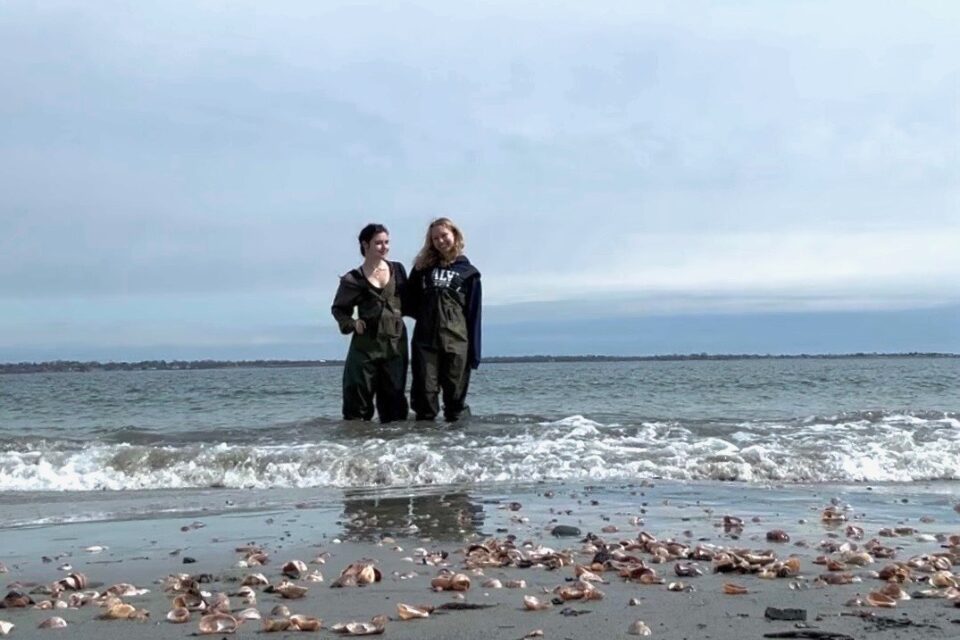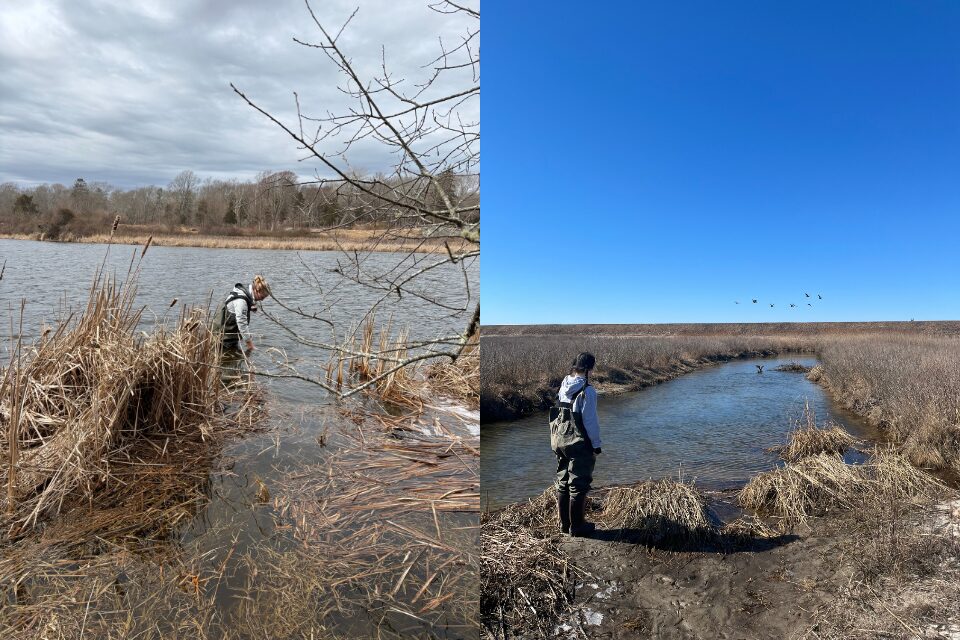SRyou Student Exposition spotlight: Students take action for clean water on Aquidneck Island

By student writer Faith Lam
Every year, the SRyou Student Exposition shines a spotlight on the incredible research, creativity and innovation of Salve Regina University students. This year, junior Colleen Brown and sophomore Kelly Schaffer are making waves—quite literally—with their project on stormwater-driven pollution in Rhode Island’s Almy Pond and Nelson Pond. Their research dives deep into the hidden dangers lurking in these local estuaries and their impact on beach water quality.
In the following Q&A, Brown and Schaffer discuss their findings, the real-world impact of their research and how their passion for environmental justice is driving them forward. From late-night lab sessions to presenting at regional conferences, their work is more than just a research project—it’s a mission to protect Aquidneck Island’s waters.
Q: Tell us about your project for the SRyou Student Exposition.
Brown: Our focus for this project has been Almy Pond in Newport, R.I. and its dangerously high bacteria levels. During the fall semester, I had started working with Dr. Jameson Chace, professor and chair of the Department of Cultural, Environmental and Global Studies, to record levels of bacteria in Almy Pond, but at first, we were just collecting data. Then, when we brought Schaffer on, we began to compare Almy Pond to Nelson Pond in Middletown, R.I., as they are similar estuaries. So it was the perfect way to show the high levels of nutrients.
Q: What inspired you to investigate Almy Pond?
Brown: There’s a concerningly high level of nutrients from stormwater runoff, which carries things such as lawn care that you would us in your garden or outside your home, which starts to kill off plants and animals – creating an inhabitable environment.
Almy Pond flows into the ocean at the local Bailey’s Beach, but no one seemed to know or care that these dangerous pollutants were in the waters we swim in. So, we have been trying to find a way for people to conceptualize it better and understand why they should care.
Schaffer: Anthropogenic environmental degradation affects so much on the island, including the coasts and landscapes that we appreciate so much. Aquidneck Island is an isolated piece of land, so our impact on the environment is so much bigger.
Q: Can you discuss the key milestones in the development of your project?
Brown: We’re planning to present at the SRyou Student Exposition and we’re also presenting at the New England Estuarine Research Society conference in Massachusetts at the end of April. We’re using this as an opportunity to gather information as well as suggestions from the professionals about how to continue our project. We’ve been doing so much research, and we really want to share what we have and get useful feedback.
Schaffer: One of our biggest moments in regard to our community engagement, is when we got such a positive response from Bailey’s Beach about our testing. We have their support in doing this research. We’re tying it back to other environmental facts and making efforts to help create awareness within the community regarding the estuary with the support of locals – so presenting at SRyou is an extension of that.
Q: What obstacles have you faced while conducting this research?
Brown: We are currently in an adjustment period of the cold weather to the warm weather, which can affect the water quality. We’ve found so far that in the cold weather, the bacteria will stay more dormant. So even if the bacteria are there, it’s not actively multiplying. For example, when we test the water and get low levels of bacteria, we know that theoretically the levels should be higher. Now that it’s getting warmer again, over the last couple weeks, we’re starting to get more levels of bacteria in our research.

Kelly Schaffer performing a phosphate test in Salve’s water quality lab.
Q: What part of this project are you most proud of?
Schaffer: As someone who doesn’t go home very often and stays here with the local community, I’m so proud that I’ve found a way to become further connected to my second home with the residents here. Being able to do that through a passion that I love and something I could see myself doing in the future as a career, makes it mean so much more to me.
Brown: I’m so proud of how much passion this project has evoked in both of us, and also how much effort we have put into this research. It takes us hours to collect samples and then hours to run tests. It has been a labor of love rather than just an assignment we have to do. Often, with lab research, it can feel like a chore, but because we’re so passionate about this, it’s enjoyable and I can’t wait to see how this will turn out.
Q: How do you plan to continue with this project in the future?
Schaffer: For us, this isn’t just a semester-long project. We want to continue this research during the summer and in the fall 2025 semester. In comparison to a lot of research that will be presented at the SRyou Student Exposition, we are still at a jumping off point with this project. We want to keep working and keep creating awareness.
Brown: This topic is something that as people, we think is important to share and research further. We want to encourage those in places of authority to be proactive about the pollution levels in Almy Pond and how it is affecting marine life, vegetation and also Bailey’s Beach and the residents.
Q: How do you think this project aligns with the University’s mercy mission?
Brown: Salve’s mission is to live in a world that is harmonious, just and merciful, but the pollution is breaking the harmony we’re trying to have with the environment of Aquidneck Island. We want environmental justice for the animals that are dying because of the nutrient and bacteria levels and the vegetation that is suffering.

Colleen Brown (left) and Schaffer (right) at sample locations.
Q: If you could offer one piece of advice to a student who’s on the fence about participating in SRyou Student Exposition, what advice would you give them?
Brown: Don’t feel the need to have completed your research in order to present at SRyou. The day isn’t only for presenting finalized research where you present your results – it is so much bigger than that. It is about sharing new ideas, sparking conversations and gaining fresh perspectives from peers and faculty alike. SRyou is about learning from others just as much as it is about sharing your own insights.
The SRyou Student Exposition will take place on Wednesday, April 2. For more information, go here.

